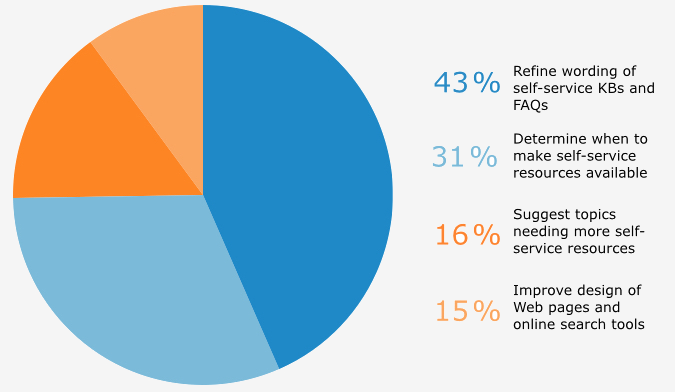As we discussed in a previous blog post, self-service support for customers is becoming increasingly more important. Not only do self-service options such as Knowledge Bases (KBs) and Frequently Asked Questions (FAQs) allow customers to resolve their own issues or ask other customers for help (forums), but they cut down on the number of customer service resources you need.
Level X Solvable is, in general, a measurement of the success of a level of customer service at any given point of contact. The “X” represents the level (or point) of contact a customer has to reach in order to have their problem solved. As an example, if an issue should be solvable by the first customer service representative (CSR) to be contacted, then that means the issue is Level One Solvable. If an issue should have been resolved at level one, and was, then LOS goes up. If the issue was not resolved at level one, then LOS goes down.
A recent survey conducted by the knowledge management evaluation company Software Advice found how the lesser-used metric Level Zero Solvable (LZS) is used by companies to determine the effectiveness, readiness and usability of their self-service options. By measuring LZS around these variables, a company could use the results to improve not only their self-service channels, but their customer service department as a whole.
The key findings of the survey were:
- 43% of respondents used LZS to refine working KBs and FAQs
- Those measuring the LZS of their self-service channels were 10% more likely to report improvement on key departmental performance metrics than those companies that did not use LZS
- LZS use most strongly correlated with the ability of a company’s self-service implementations to improve LOS and reduce new agent training hours
Level Zero Solvable
Level Zero Solvable is a measurement of customer service issues that could have been resolved by the customer themselves, usually through a KB or FAQ, without ever having to contact customer service. LZS is typically based upon internal testing by a company. If a CSR is able to follow a KB or FAQ in order to answer a customer’s question or solve their issue, then in theory the customer should be able to follow the same documentation without ever having to contact customer service.
LZS provides customer support with three important pieces of information:
- LZS measures success from the customer’s point of view (of your KB or FAQ).
- LZS is used to determine when a self-service resource should go live.
- LZS can indicate when self-service resources need improvement (after having gone live).
Be the Customer
In order to start measuring Level Zero Solvable, you need to look at your self-service channels the same way a customer would – from the beginning. Typically, a customer will not have any detailed knowledge of your KBs or FAQs, or may even be using them for the first time. Their first step will be to do something simple, like find the solution they need by searching for their literal question or problem.
As a CSR, you know to some degree what you are looking for because you are familiar with the products you service, but that kind of knowledge can’t be assumed of a customer. What you can assume is that the customer may have only working knowledge of what their problem is, and therefore they may take the most intuitive route, not the most technical savvy one.
Review, Refine, Release
Keeping in mind that self-service channels are created and maintained by individuals who already have knowledge of a product, most self-service channels cannot simply be released to the public. Companies have to internally test their KBs and FAQs, rewriting, adding, modifying, deprecating, and constantly keeping them up-to-date. LZS, however, helps simplify this. If a company knows exactly which areas of its LZS are useful as-is, which ones need updating, and which ones are incomplete (from the eyes of the customer), then they can focus their efforts. In fact, the survey by Software Advice found that nearly 43% of individuals who use LZS use it to refine pre-existing KBs and FAQs.

Conclusion
One of the important takeaways from the survey is that LZS isn’t just a metric to determine the success of a company’s self-service channels. It can be used as an indicator of how well a company focuses on customer needs and on the overall success of a customer service team.
The importance of customer self-service support is growing. More customers are expecting immediate answers, and the easiest way for a customer service team to provide solutions is to help the customer help themselves. LZS not only helps a company do this, but it helps measure, track and keep your CSRs on top of growing trends in your customers’ needs.
“Support” image courtesy of Stuart Miles at FreeDigitalPhotos.net




Comments are closed.